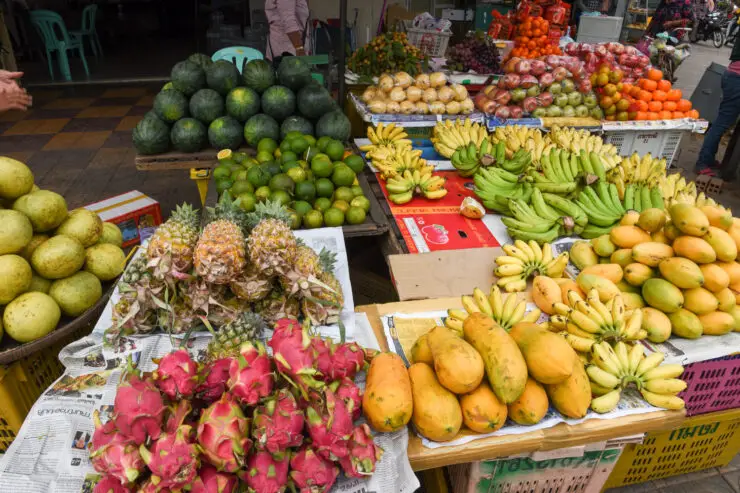As an Amazon Associate I earn from qualifying purchases. Please read the disclaimer for more info.
Are you a fruit lover looking for new and exotic flavors to add to your next trip to Aisa? Look no further than the bountiful selection of exotic Asian fruits!
From the sweet and tart mangosteen to the creamy and tropical durian, Asian fruits offer a variety of unique flavors, textures, and appearances that will make your mouth water.
But these fruits aren’t just delicious – they also offer numerous health benefits, such as boosting immunity and aiding digestion.
Read on to discover 39 exotic Asian fruits that you must try.
- Dragon Fruit
- Sugar Apple
- Lychee
- Passion Fruit
- Snake Fruit
- Asian Pear
- Star Fruit
- Mango
- Java Apple
- Guava
- Rambutan
- Durian
- Mangosteen
- Jackfruit
- Longan
- Lotus Fruit (Nelumbo nucifera)
- Papaya
- Custard Apple (Soursop)
- Pomelo
- Bael Fruit
- Mosambi
- Chinese Bayberry
- Langsat
- Pulasan
- Meyer Lemon
- Sapodilla
- Goji Berries
- Kumquat
- Breadfruit
- Sweetsop
- Tamarillo
- Tamarind
- Noni
- Yuzu
- Persimmon
- Coconut
- Hog Plum
- Gac Fruit
- Fuji Apple
39 Exotic Asian Fruits to Try on Your Next Asian Holiday
Dragon Fruit
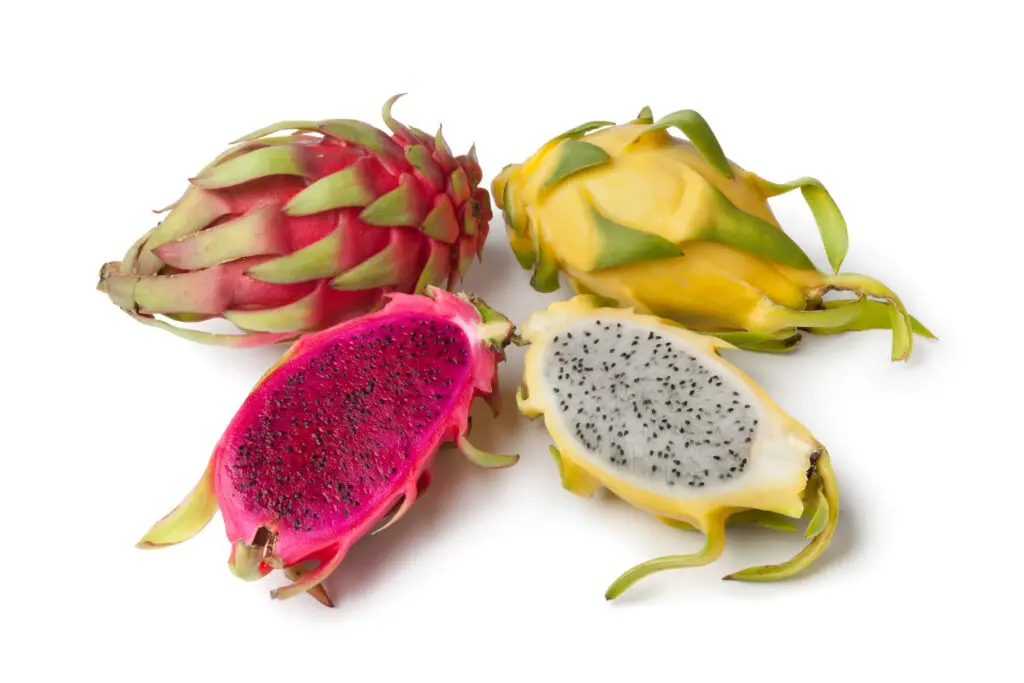
Dragon fruit, also known as pitaya, is a unique and exotic Asian fruit that is widely grown throughout the region.
With its bright pink or yellow skin and speckled green scales, the dragon fruit is a visually striking fruit that immediately captures your attention. Beyond its appearance, the taste of the dragon fruit is equally memorable.
With a subtly sweet flavor and crunchy texture, the fruit is often compared to a kiwi.
Rich in antioxidants and fiber, the dragon fruit is as healthy as it is delicious.
Sugar Apple
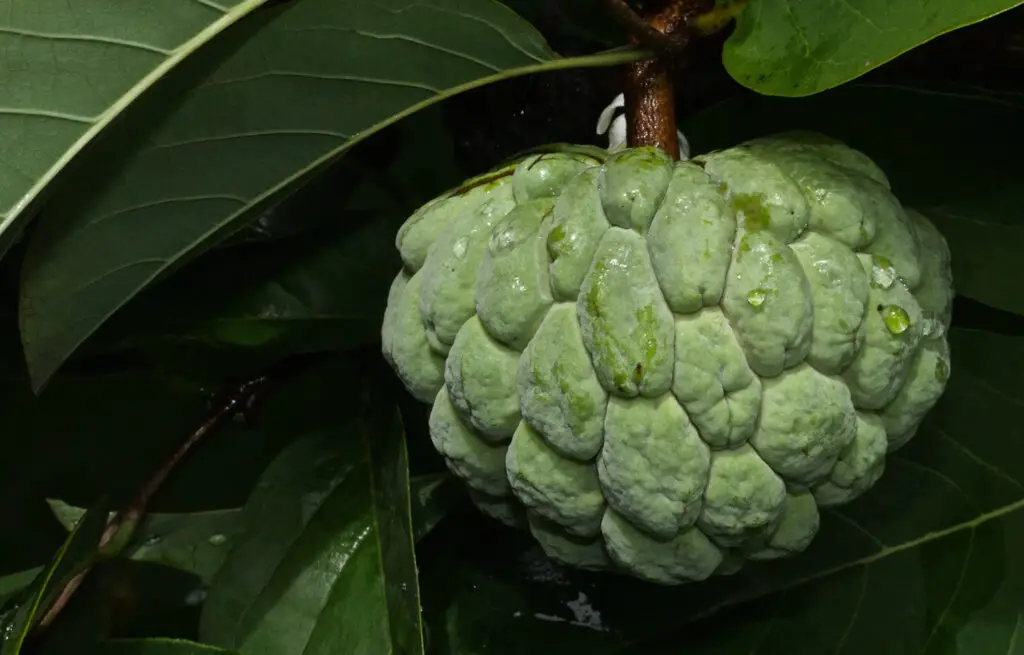
The sugar apple, known as “noina” in Thai, “atis” in Filipino, and “fan li zhi” in Chinese, is a unique fruit that is native to Asia.
With a green, scaly exterior and creamy white flesh, the sugar apple is an exotic delicacy highly sought after for its sweet and tangy taste. This tropical fruit is a prominent ingredient in many Asian desserts, including ice cream, smoothies, and cakes.
Sugar apples are widely cultivated throughout Asia and are a popular street food in many countries, where they are served fresh and sliced into bite-sized pieces.
Not only is this fruit delicious, but it also contains many health benefits, including high levels of vitamin C and antioxidants.
Lychee
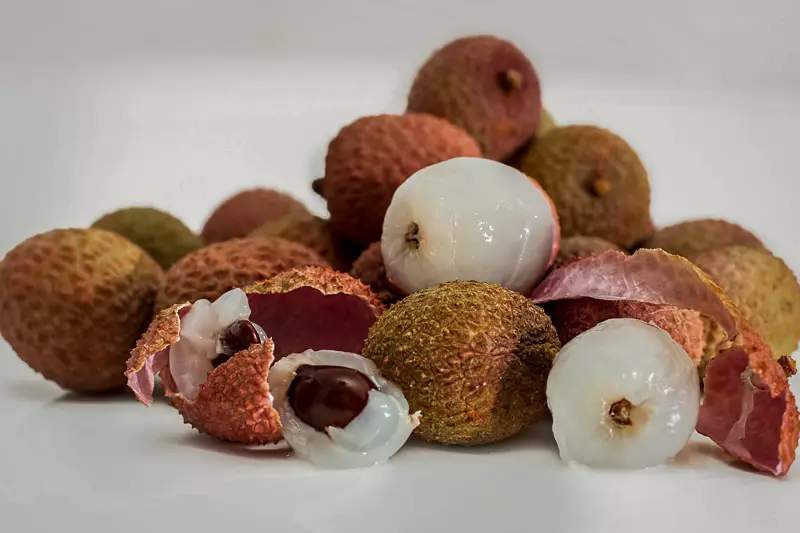
Lychee is a popular Asian fruit with a unique flavor and texture. Originating from southern China, it has spread across Southeast Asia and beyond.
The lychee fruit is a small, round fruit with a rough red shell easily peeled away to reveal juicy white flesh.
Its taste is sweet and floral, with a hint of tartness. Not only is it delicious, but it also contains essential vitamins and minerals.
In many Asian cultures, lychee symbolises good luck and prosperity, making it a common sight in festivals and celebrations.
For more information on Lychees, you can read more on Lychee Juice or try one of the refreshing Lychee cocktails here:
Passion Fruit

Passion fruit may not immediately come to mind when thinking of Asian fruits, but this small, oval-shaped fruit is quite popular in many countries throughout the continent.
The fruit is known for its vibrant purple exterior and unique flavor, which is sweet and tart.
In addition to being tasty, passion fruit is also quite nutritious, packed with fiber, antioxidants, and vitamins A and C.
Whether enjoyed on its own or used as an ingredient in everything from drinks to desserts, passion fruit is a beloved fruit in Asian cuisine.
Snake Fruit
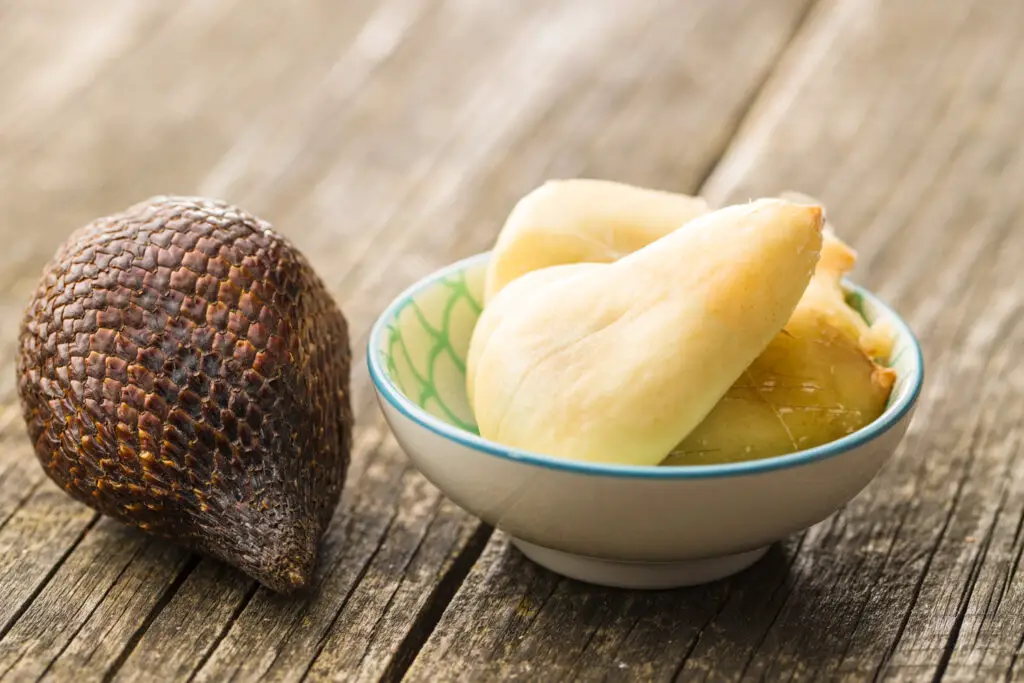
When it comes to unique Asian fruits, snake fruit is definitely at the top of the list.
This exotic fruit, also known as salak, has a scaly brown exterior that looks almost like snake skin, hence its name.
But don’t let its appearance fool you because inside lies a sweet and tangy flesh comparable to a mix of pineapple and apple.
Native to Indonesia, snake fruit is popular throughout Southeast Asia and has even found its way into Western markets in recent years.
With its distinct flavor and interesting texture, snake fruit is worth trying if you can.
Asian Pear
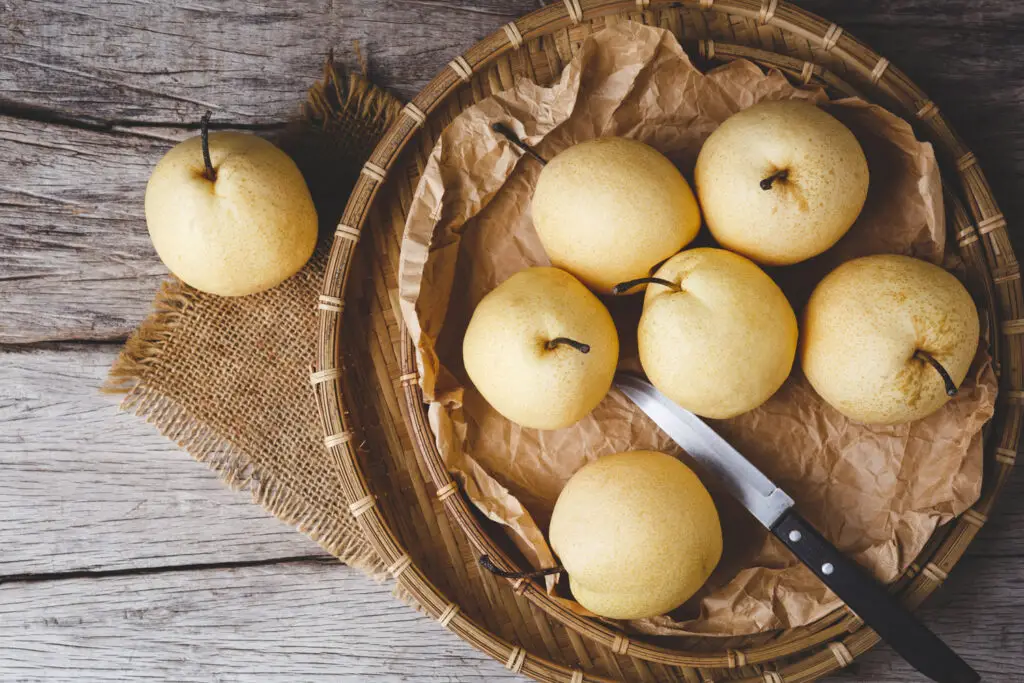
Asian pears are a unique and delicious Asian fruit that is a must-try for all fruit enthusiasts.
Originally from China, these pears have become increasingly popular in other parts of Asia and worldwide.
Their crispy and juicy texture, reminiscent of an apple, sets them apart from other pears.
They are often eaten raw in Asia as a healthy snack or used in traditional dishes and desserts.
The versatility of the Asian pear is unparalleled with its sweet and refreshing taste making it perfect for pairing with savory meats or used as a topping for salads.
Star Fruit
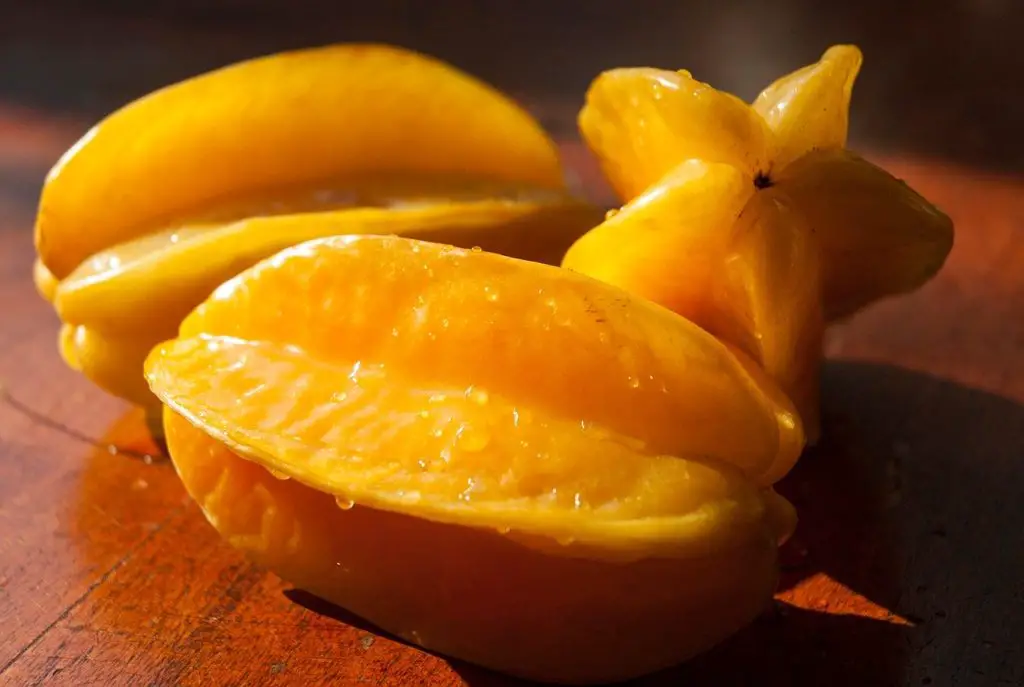
This tropical delicacy, also known as carambola, is a waxy, yellow-green fruit with a distinct star shape when sliced horizontally.
Native to Southeast Asia, these fruits are now widely cultivated in various parts of the continent, including India, Thailand, and Malaysia.
With its sweet and tangy flavor and juicy texture, star fruit has become popular in many Asian cuisines, from savory dishes like stir-fries and curries to desserts like sorbets and jellies.
Its eye-catching appearance and refreshing taste make star fruit a must-try for anyone exploring exotic Asian fruits.
Mango

The mango, an Asian fruit, is a sweet and juicy tropical fruit that has captured the hearts of many across the globe.
Originating from India, its distinct flavor and fragrance have made it a favorite among fruit lovers worldwide.
The fruit comes in various shapes and sizes, with its skin ranging from green to yellow to red.
Eating a ripe mango is a true delight, with its soft and creamy flesh that seems to melt in your mouth like butter.
Whether eaten raw by itself or as an ingredient in recipes, such as Thai mango sticky rice or the ever-popular mango lassi, this fruit is a true treasure of Asia that brings a burst of flavor and sweetness to any dish.
Java Apple
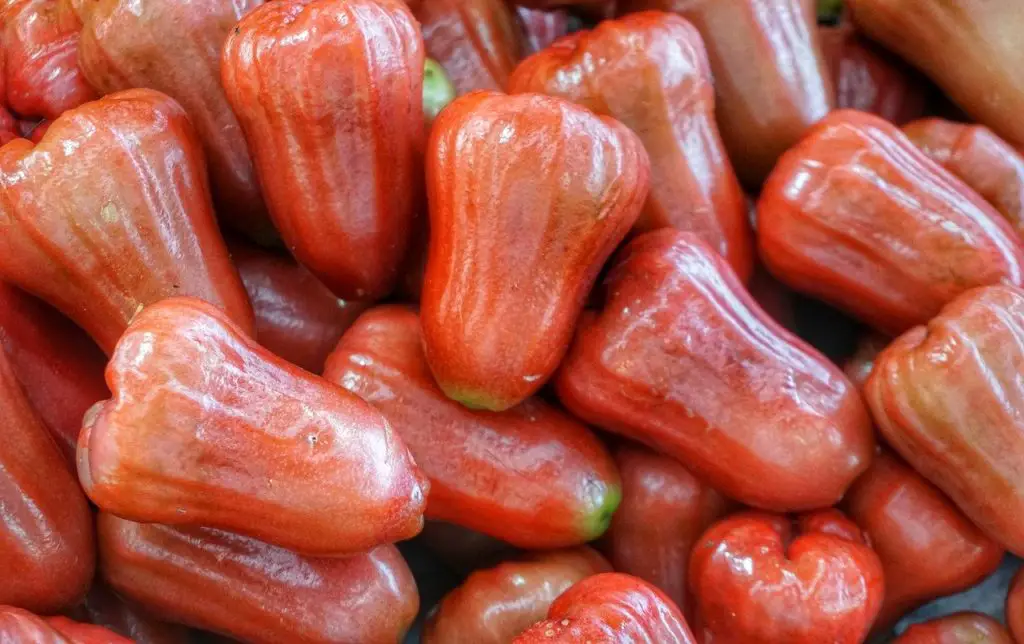
Java apples, also known as rose apples or wax apples, are a delicious and unique tropical fruit that originates from Asia.
Its crisp and juicy texture and subtly sweet flavor make it a popular fruit among locals and tourists alike.
The fruit is believed to have originated in the Southeast Asian region and is widely cultivated in countries such as Thailand, Vietnam, and Malaysia. What makes this fruit truly special is its appearance – its shape and color resemble that of a small rose, which adds to its allure.
It is commonly eaten as a snack in Asia or used in traditional dishes such as fruit salads and desserts.
Overall, the java apple is a must-try fruit for anyone visiting Asia, as it offers a delightful taste and cultural experience all in one bite.
Guava
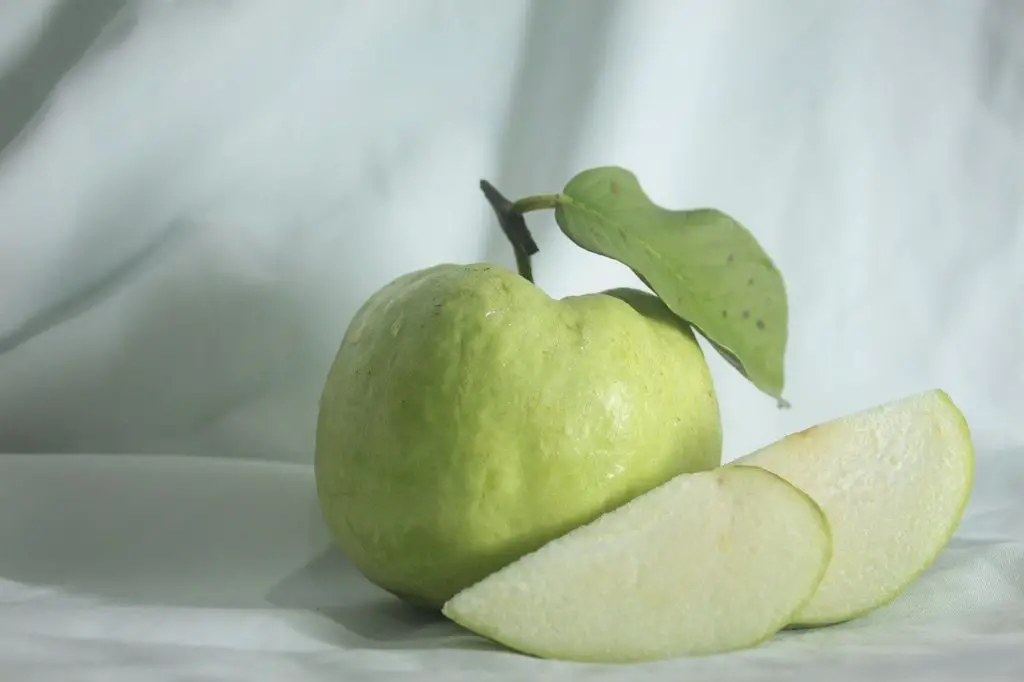
Guava is one of the Asian fruits that has found a home in many Asian countries. It is a popular fruit in places like India, Thailand, Indonesia, and the Philippines.
Asian guavas come in different varieties but generally have a sweet and tangy taste with a crunchy flesh.
They are often eaten fresh or used in salads, desserts, or smoothies. They can also be made into jams, jellies, and candies.
Guavas are also known for their health benefits. They are high in vitamins C and A, potassium, and fiber, making them great for boosting immunity and aiding digestion.
In some cultures, guava fruit leaves are boiled to make a tea that is believed to have medicinal properties.
Rambutan
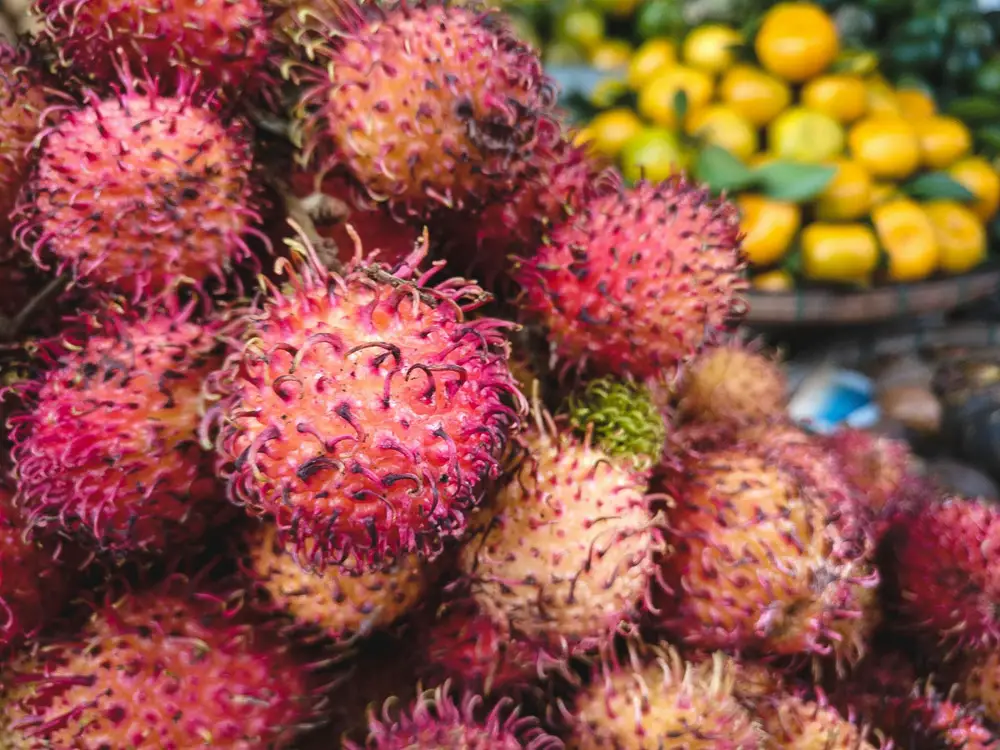
Also known as Nephelium lappaceum, rambutan is a hairy, red fruit resembling hairy lychee.
It is native to Southeast Asia and can be found predominantly in countries like Malaysia, Indonesia, and Vietnam.
Rambutans are rich in vitamin C and manganese, which boost immunity and maintain strong bones.
They are typically eaten fresh by peeling off the hairy outer layer to reveal the sweet, juicy flesh.
Rambutan can also be found canned or frozen at supermarkets and Asian markets abroad.
Rambutan is sometimes confused with longan and lychee and we have a similarities and differences post to answer your questions!
Durian
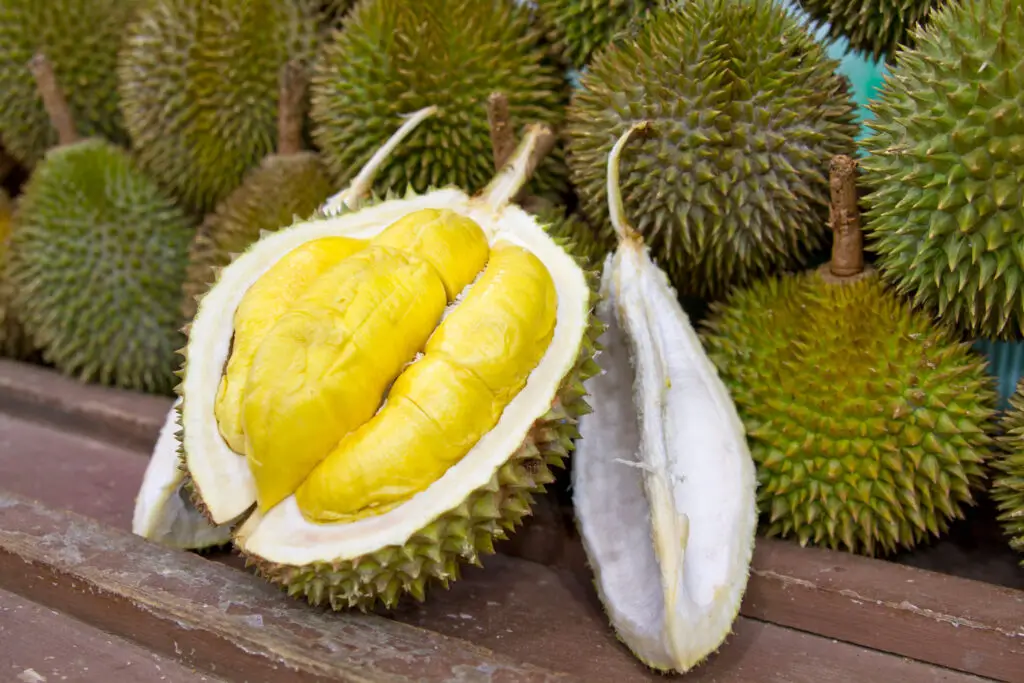
Dubbed the “King of Fruits,” durian (Durio zibethinus) is loved and reviled for its unique aroma, which can be pungent and offensive to some.
It is particularly popular in Southeast Asian nations like Malaysia, Singapore, and Indonesia.
Durians are packed with vitamin C, potassium, and healthy monounsaturated fats.
The creamy-textured fruit is often eaten fresh but can also be found in various desserts, like durian ice cream or cakes.
While durian might not be widely available in typical grocery stores, it can be found in specialized Asian markets.
Mangosteen
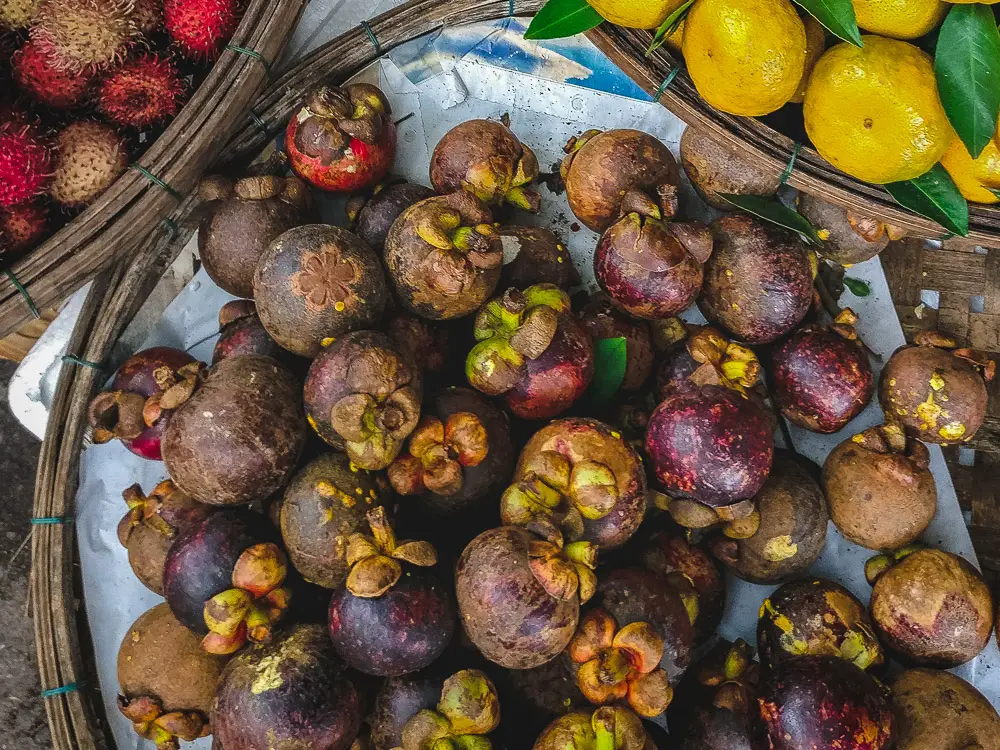
Mangosteen, the jewel of the tropics, is a delightful fruit that grows in Southeast Asia.
With a hard purple rind, the juicy interior of the fruit is white and tastes sweet with a hint of tanginess.
Known for its unique flavor profile, the fruit is said to have a taste reminiscent of a combination of strawberries, peaches, and vanilla. Eating mangosteen is an experience in itself, as it takes time to carefully peel off the thick rind and savour the fruit.
In Asian culture, mangosteen is not just a fruit but is also used in traditional medicine due to its potential health benefits.
Rich in antioxidants and anti-inflammatory properties, the fruit is believed to have healing effects on the body.
With its exotic taste and various uses, mangosteen is truly a wonder of Asian fruit.
Jackfruit

Jackfruit is the largest tree-borne fruit in the world and a staple in Southern India, Bangladesh, and parts of Southeast Asia.
It has a distinctive mildly sweet taste and a fragrant aroma, making it a popular ingredient in Asian cuisine.
The flesh of this Asian fruit has a unique texture that can be described as a blend of banana and pineapple.
Jackfruit seeds are also edible and can be roasted or boiled.
Jackfruit is delicious and has many health benefits, including being a good source of potassium, vitamin C, and fiber.
Longan
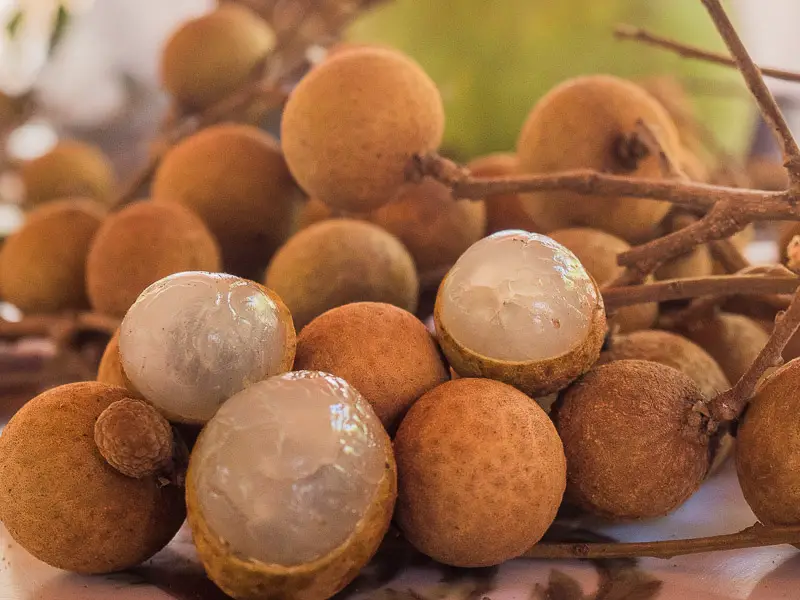
Longan, an exotic fruit from Southeast Asia, is a close relative of lychee, with a brownish outer shell and translucent, juicy flesh.
Longan is packed with iron, vitamins, and antioxidants.
It is most commonly eaten raw, but can also be dried and used in traditional Chinese medicine.
Fresh longan is available in Asian markets during summer, while dried longan can be found year-round.
Lotus Fruit (Nelumbo nucifera)
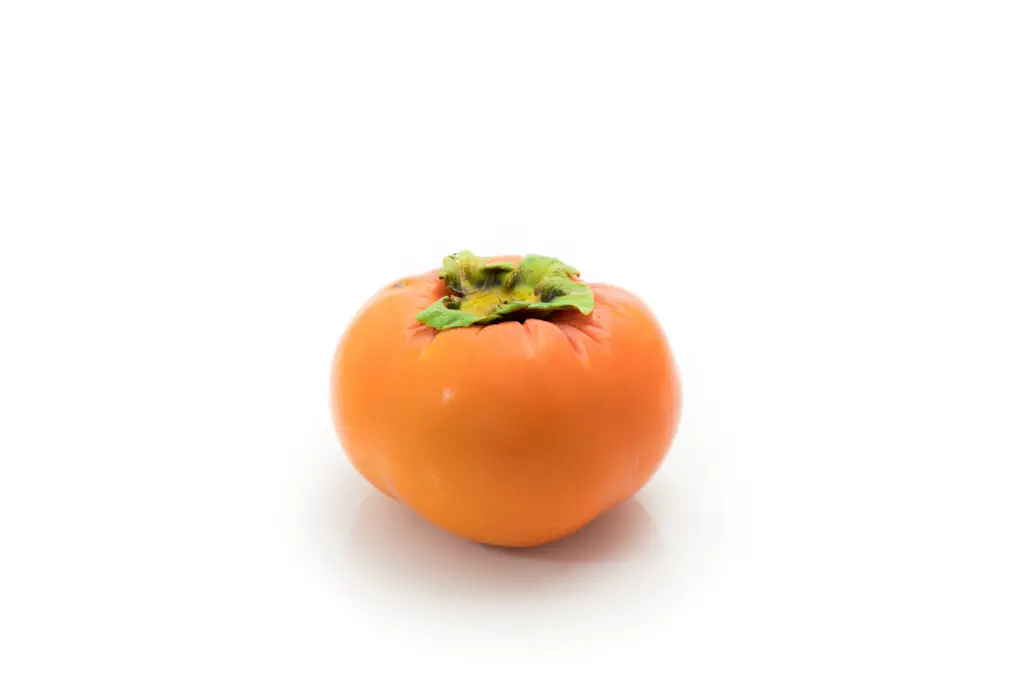
The sacred lotus is an aquatic plant native to Asia known for producing eye-catching lotus fruit.
The seeds of the lotus fruit are consumed and are said to have numerous health benefits, including reducing anxiety and improving digestion. Although the seeds are not commonly found in Western markets, you may be able to find lotus seeds sold dried or canned in Asian grocery stores.
These seeds can be added to soups and congee or boiled to make a sweet dessert.
Papaya
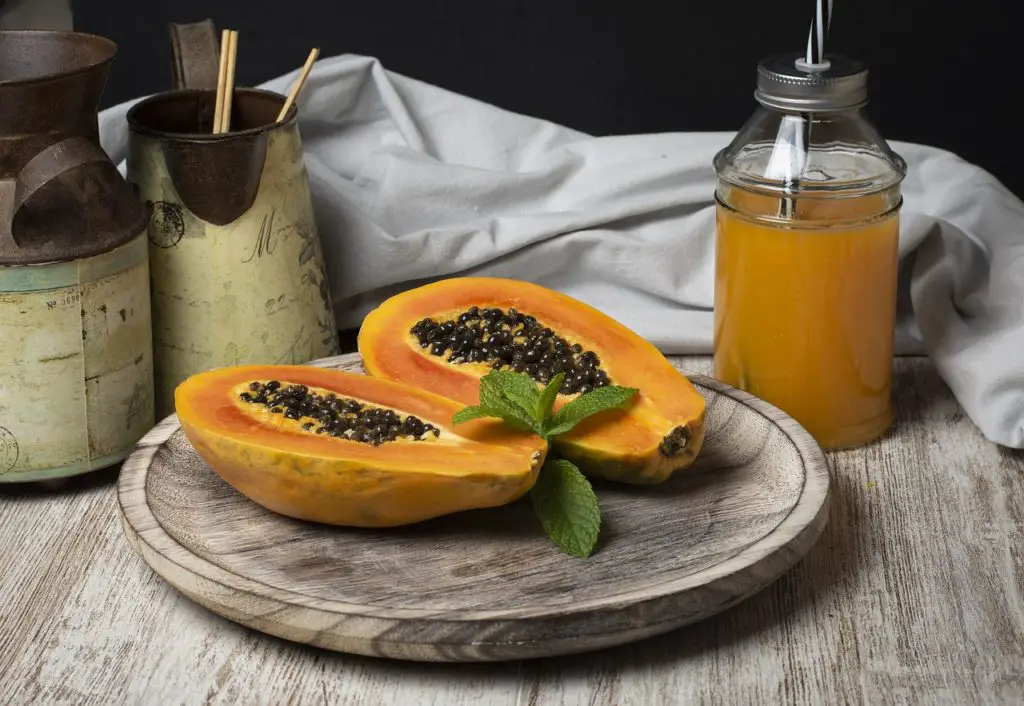
Papaya, an exotic and tropical Asian fruit, is a staple in many Asian cuisines.
Its unique, slightly sweet, and musky flavor makes it a favorite among fruit enthusiasts.
Papaya is packed with essential vitamins and minerals, making it a popular choice for health-conscious individuals.
In Asia, papaya is often used in desserts and savory dishes, adding a burst of bright orange color to any plate.
Its versatility makes it a must-have ingredient in many Asian kitchens, and its health benefits ensure it remains a go-to fruit choice for many.
Custard Apple (Soursop)
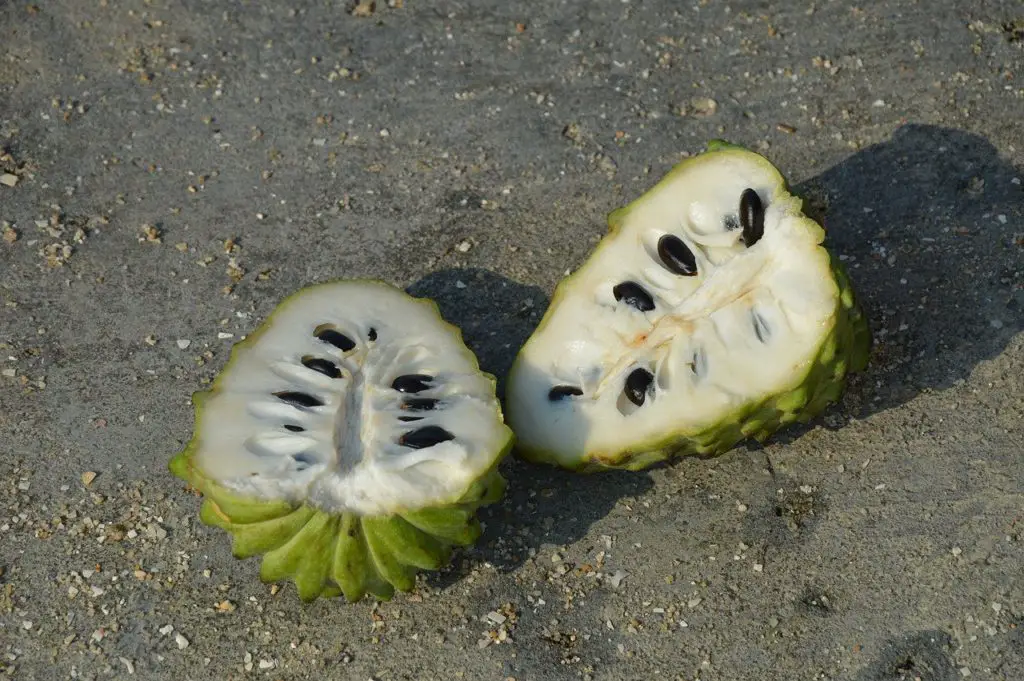
The custard apple, or soursop, is a sweet and creamy fruit from Southeast Asia.
It has a green outer skin with prickly bumps and a soft white interior filled with black seeds.
The creamy texture and sweet flavor make it a popular ingredient in many Asian desserts, and it’s often eaten as a snack on its own.
Custard apple is not only delicious but it also healthy as it is packed with numerous vitamins, minerals, antioxidants, and dietary fiber.
Pomelo
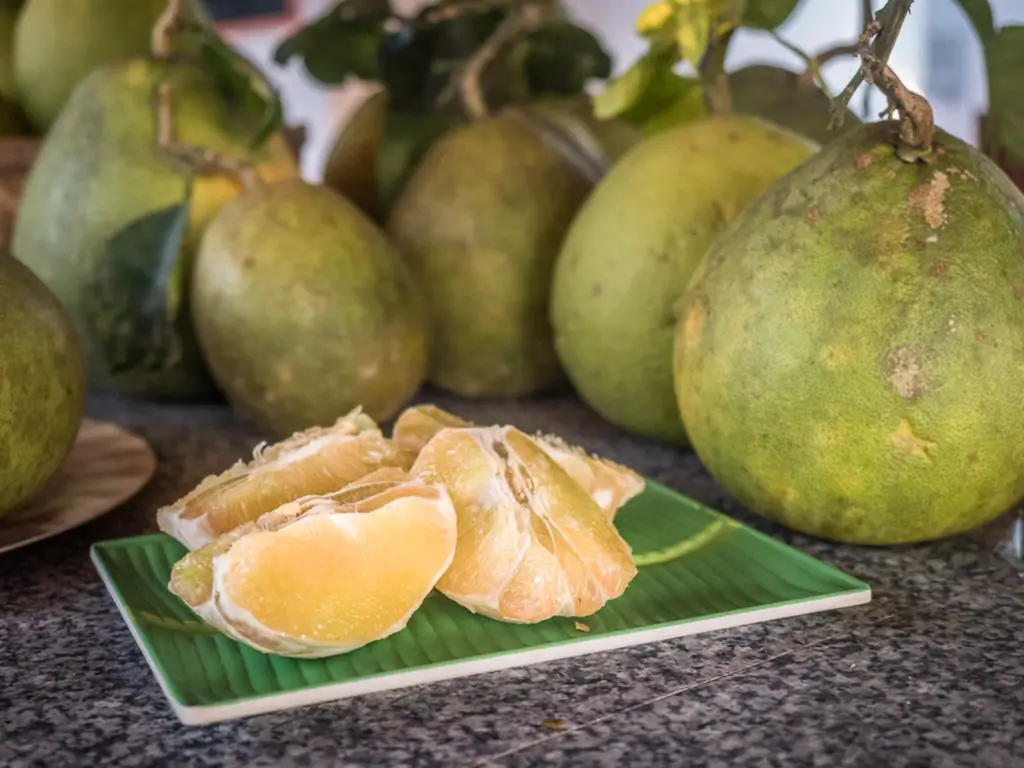
If you’re looking for an Asian fruit that’s both refreshing and unique, look no further than the pomelo.
This large citrus fruit is a beloved staple in many Asian countries and is celebrated for its sweet yet slightly tart taste.
Pomelos are a great source of Vitamin C and dietary fiber, making them tasty and healthy.
The fruit’s thick white pith is often used in cooking, while the juicy flesh is perfect for snacking or adding to salads.
Its size can be intimidating initially, but don’t let that deter you from trying this Asian delicacy.
Bael Fruit

Bael fruit, also known as Aegle marmelos, is a popular Asian fruit highly sought after for its nutritional benefits and zesty flavor.
The fruit’s unique taste is often described as a combination of sweet, sour, and bitter notes, making it a versatile ingredient in many Asian cuisines.
It tastes amazing and is known for its numerous health benefits, such as boosting digestion and immunity, reducing inflammation, and promoting weight loss.
Whether you enjoy it raw, cooked, or in a refreshing juice, this exotic fruit is sure to delight your taste buds and improve your health at the same time.
Related: 19 African Fruits You Need to Try
Mosambi
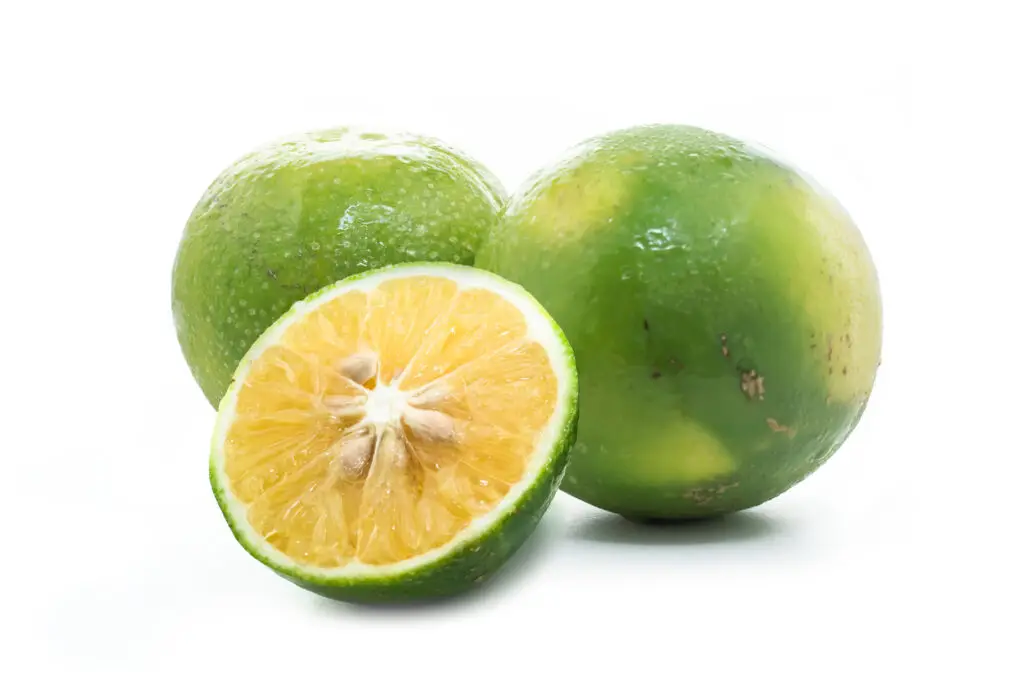
Originating from Southeast Asia, the mosambi fruit is a regional gem. With its slightly oval shape and vibrant green exterior, this juicy Asian citrus fruit is prized for its refreshing taste and numerous health benefits.
Popularly known as sweet lime, it boasts a tangy, sweet, and slightly sour flavor, making it a favorite in Asian cuisine.
Mosambi not only excels in taste but is also full of nutrients.
It’s high in vitamin C, antioxidants and has anti-inflammatory properties making it a great addition to anyone’s diet.
From its taste and health-related benefits, it’s no wonder why mosambi is a fruit that has earned a place in the hearts of Asians.
Chinese Bayberry
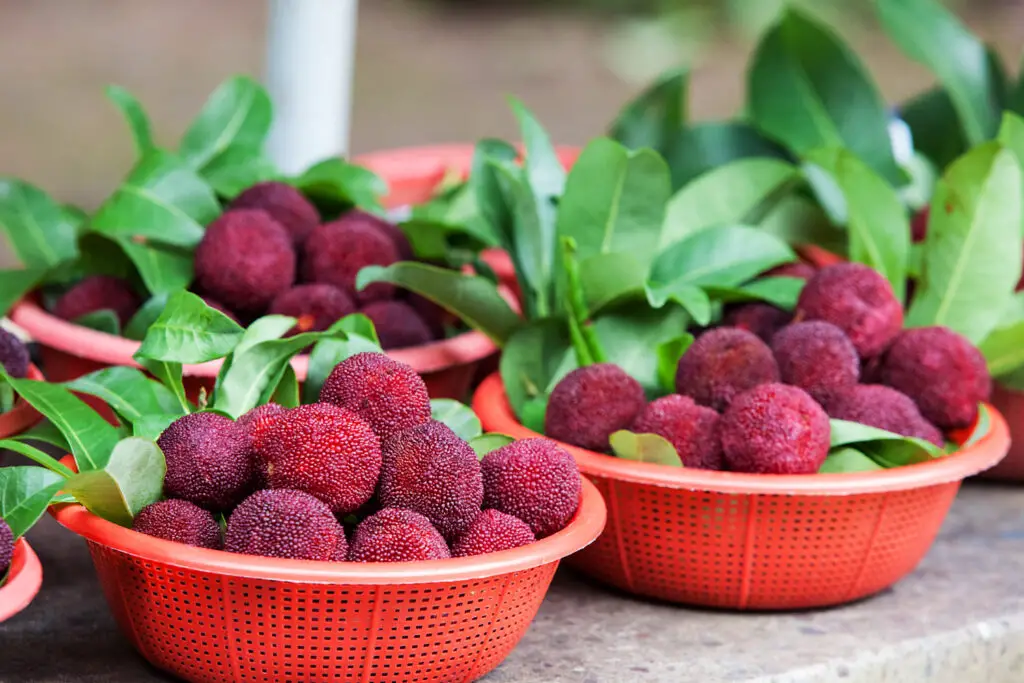
Chinese Bayberry, also known as Yang Mei, is a delicious and unique Asian fruit that is sure to excite your taste buds.
Originating from China, these small, round fruits have a rough exterior with a vibrant red or brown color.
Once you bite into the fruit, you’ll be met with a juicy and slightly tart pulp, a flavor often described as a mix of raspberry, strawberry, and grape.
Chinese Bayberry is tasty and packed with vitamins C, B, and E, making it a great addition to your diet.
Langsat
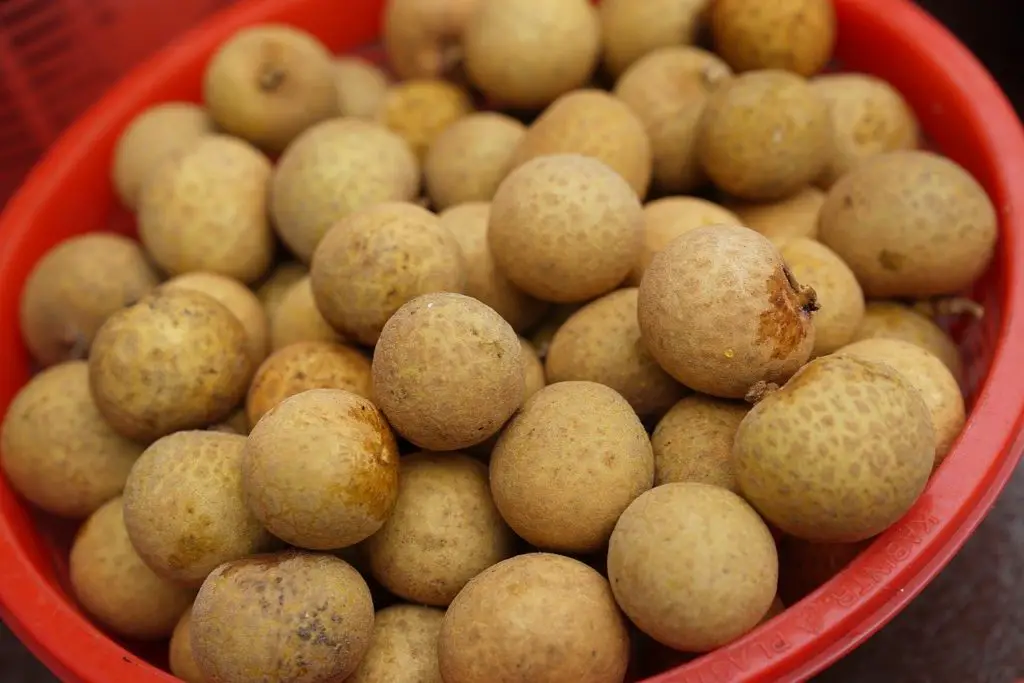
Langsat is a delightful fruit that originates in Southeast Asia. Its thin skin peels away easily, revealing a translucent, juicy flesh that tastes sweet and slightly tart.
People describe its flavor as similar to a grapefruit without the bitter aftertaste.
Langsat is commonly enjoyed as a snack but is also used in many recipes to add a tropical twist to meals. This fruit is delicious and packed with vitamins and minerals such as vitamin C, potassium, and fiber.
Langsat may be lesser-known than other Asian fruits like mangosteen or durian, but it deserves a spot on your next food adventure.
Related: Top 20 Fruits in Zanzibar
Pulasan
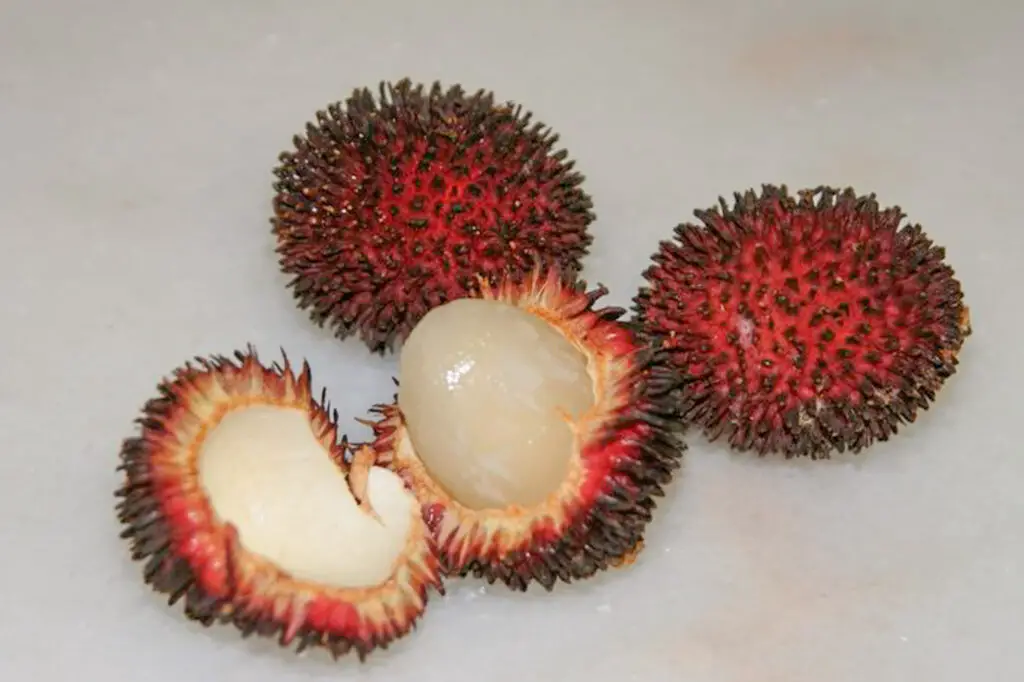
When it comes to exotic Asian fruits, the Pulasan deserves a spot on the list.
This delectable fruit is indigenous to Malaysia and is often compared to its more well-known cousin, the rambutan.
Like rambutan, Pulasan is covered in spiky red skin that is easy to peel away.
However, the juicy and sweet flesh inside the fruit truly sets it apart.
With a texture similar to a grape, pulasan’s flesh is translucent and almost gelatinous in consistency.
The flavor is slightly tart with notes of sweetness, making it a refreshing treat on a hot summer day.
While the fruit may be difficult to find outside of Southeast Asia, it’s a must-try for any foodie looking to expand their palate.
Meyer Lemon

Meyer Lemon is an Asian fruit that originated in China that was introduced to America by Frank N. Meyer, an agricultural explorer from the United States Department of Agriculture, in 1908.
This versatile fruit boasts a unique flavor that is a cross between a lemon and a mandarin orange, and it has quickly become popular in the culinary world.
Its thin, smooth skin and juicy pulp make it a great addition to recipes for savory and sweet dishes alike.
In Asian cuisine, Meyer Lemon is often used in sauces, marinades, and dressings to add a bright, tangy flavor.
Sapodilla
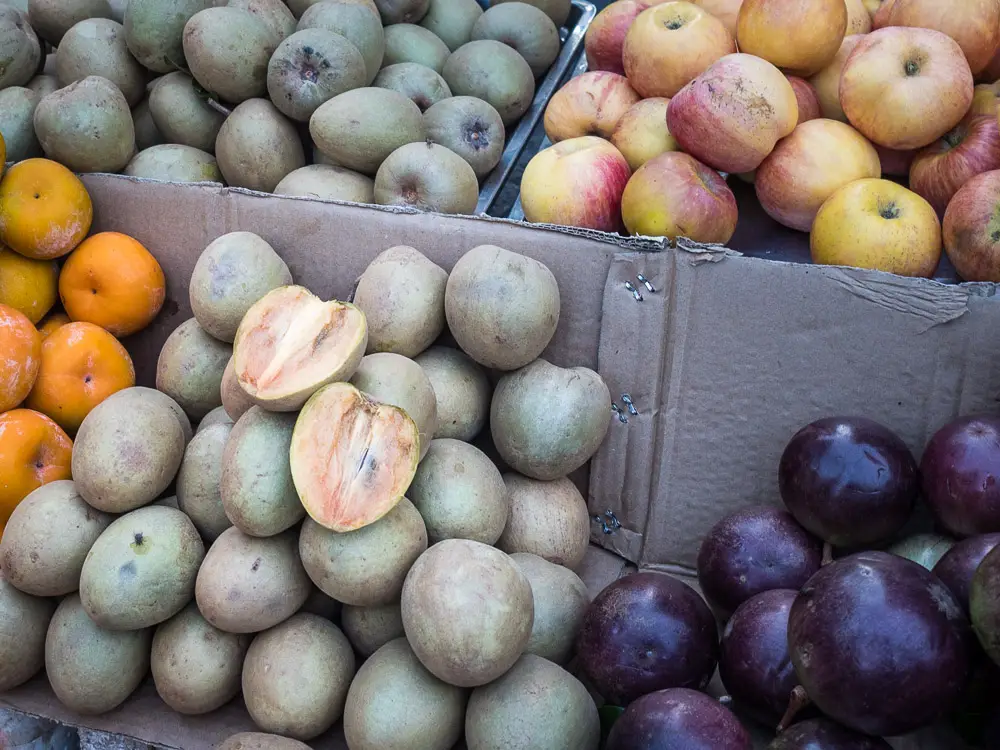
Sapodilla is a unique fruit from Asia and has slowly been introduced to other parts of the world.
This delicacy is commonly known as manilkara zapota and possesses an irresistible sweet flavor that is often described as a cross between brown sugar and caramel.
The fruit is small, about the same size as a pear or apple, and is tough on the outside with soft and juicy flesh within.
Goji Berries
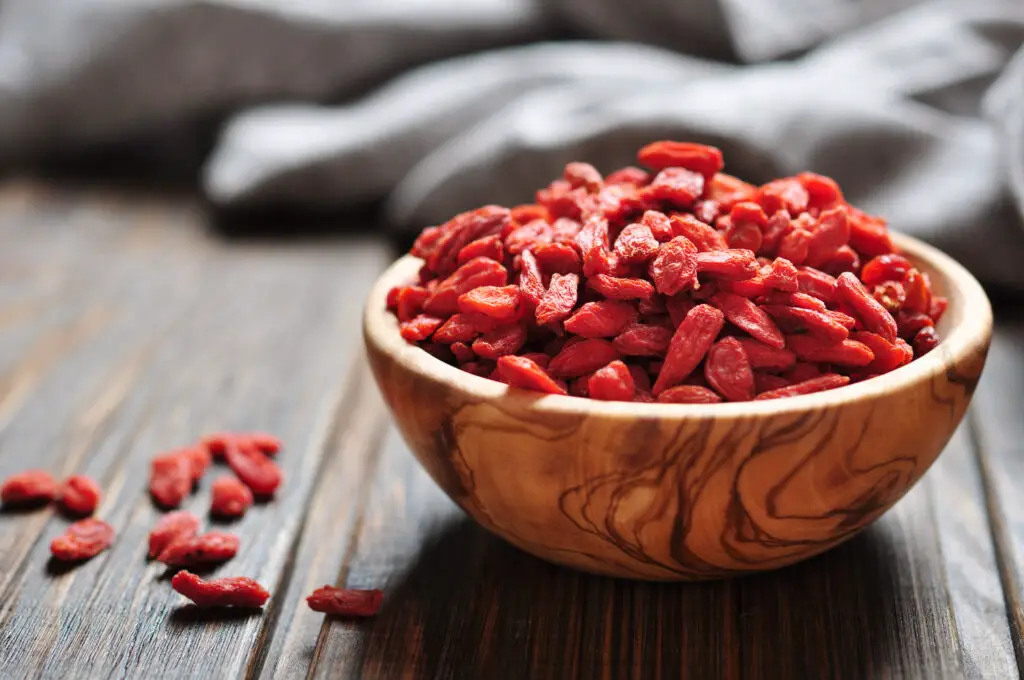
Goji berries, or wolfberries, are popular Asian fruits in Chinese cuisine.
These small, red berries are native to China and have been used in traditional Chinese medicine for centuries due to their numerous health benefits.
In recent years, goji berries have gained global recognition for boosting the immune system, enhancing brain function, and improving vision. Often eaten dried, goji berries are a versatile ingredient in both sweet and savory dishes.
Kumquat

Kumquat, the diminutive fruit of Asian origin, is a fascinating addition to the world of exotic Asian fruits.
Known for its slightly sour and tangy flavor, it is a delicacy that has slowly but surely gained popularity around the world.
One can identify kumquats by their small, oval shape and their bright orange color.
Despite its size, it includes an impressive amount of health-related benefits such as antioxidants, fiber, and good amounts of vitamin C. Kumquats are versatile too; they can be eaten as fresh fruit, made into jams and preserves, or a garnish for cocktails.
Breadfruit
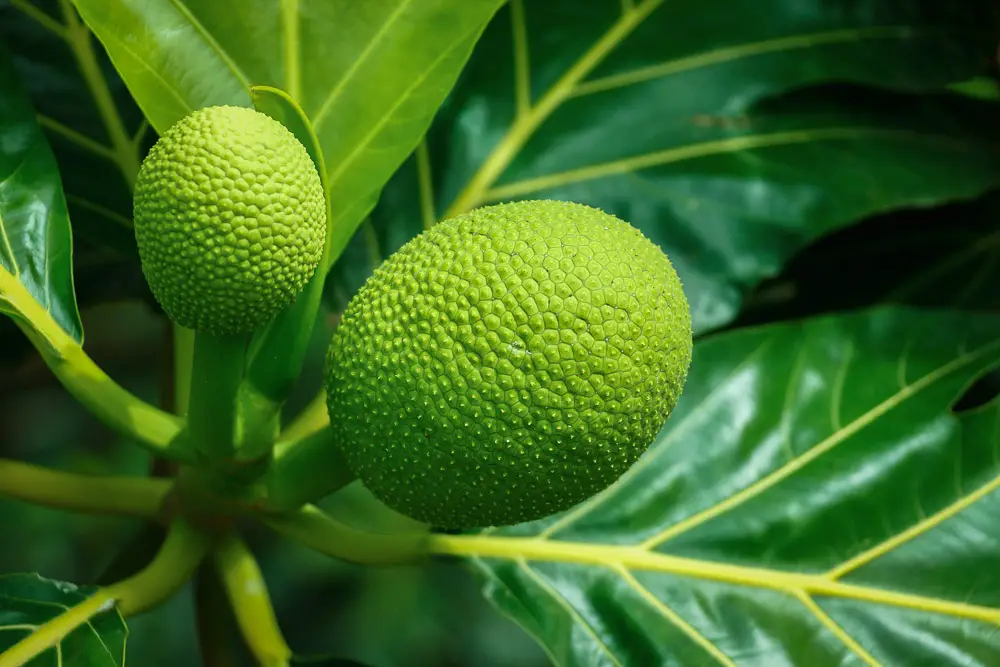
Breadfruit is a staple crop in the Caribbean and a cherished fruit in Asian countries.
Commonly known as ‘ulu’ in the Pacific, breadfruit gets its name from the texture and taste of its flesh, which is bread-like and has a potato-like flavor.
This fruit is most commonly found in Southeast Asia and is used in various Asian dishes, including stir-fries, curries, and stews.
Its dense and starchy texture can easily replace rice or noodles in a meal.
No matter how you choose to enjoy it, breadfruit is undoubtedly a unique and delicious fruit that deserves more recognition in the Asian fruit world.
Related: 15 Delicious Fruits in Bali
Sweetsop
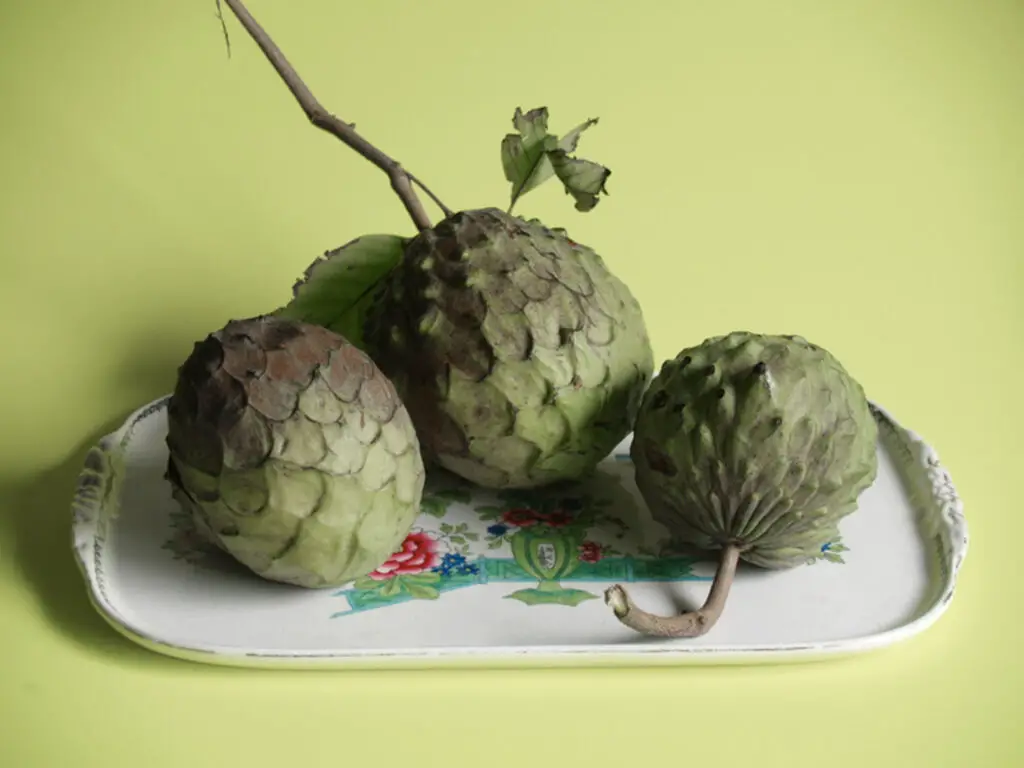
Sweetsop is a beloved Asian fruit that has gained popularity worldwide for its unique, sweet taste and numerous health benefits.
Also known as Filipino custard apple, this fruit is native to the tropical regions of Southeast Asia, but can now be found in many other countries.
The fruit is typically about the size of a large grapefruit and has a bumpy green exterior that reveals a creamy, custard-like flesh with black seeds.
The flavor resembles a combination of pineapple, strawberry, and banana with a hint of citrus.
Tamarillo

Tamarillo, also known as the tree tomato, is a unique fruit from Peru and was introduced to Asia in the early 20th century.
This egg-shaped fruit has vibrant red or yellow tough and bitter skin and contains nutrients such as vitamins A, C, and E, potassium, and fiber.
Tamarillo has a tangy and slightly sweet flavor, making it a favorite ingredient in Asian cuisine.
It is commonly used in sauces, marinades, and chutneys, and it is also delicious when grilled or baked.
In some Asian countries, tamarillo is also brewed as a tea, which is popular for its medicinal properties.
Tamarind
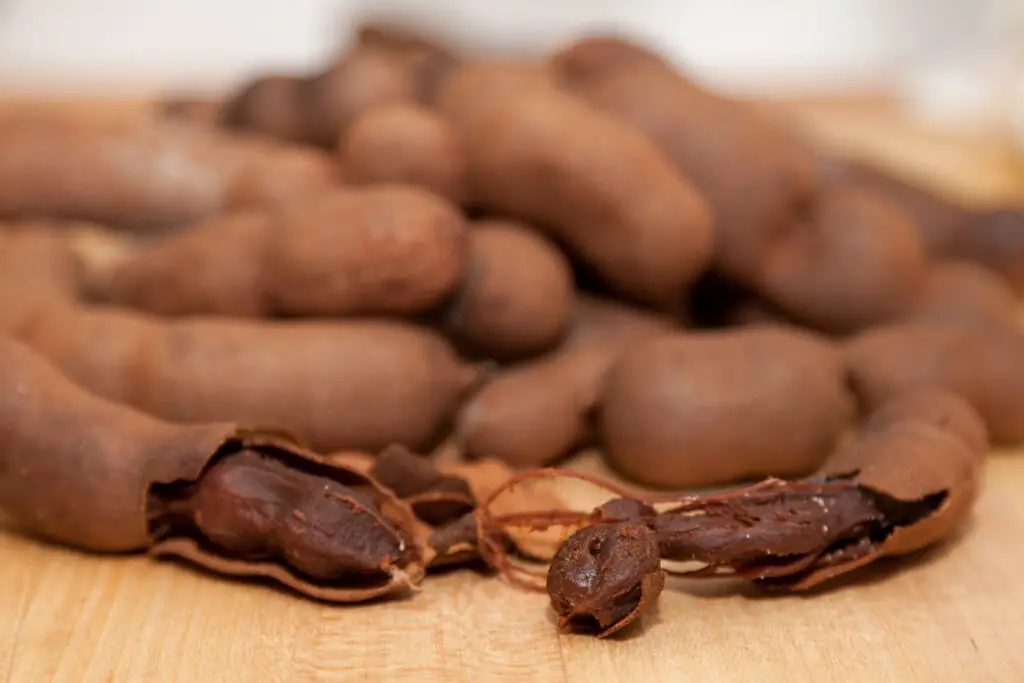
Tamarind is a distinctively sour fruit that is often used to add a zesty zest to dishes throughout Southeast Asia. These tropical fruits are about the size of a thumb and are covered in a brown, fibrous shell that must be peeled away before eating.
Once inside, the fruit is a pulpy, sticky mass filled with seeds. Despite its unappealing appearance, tamarind is renowned in the region for its tangy, acidic flavor.
It is commonly used in curries, chutneys, sauces, and salads, and can be found anywhere from street vendors to high-end restaurants.
In addition to its unique taste, tamarind is also believed to offer numerous health benefits, including aiding digestion and lowering cholesterol.
Noni
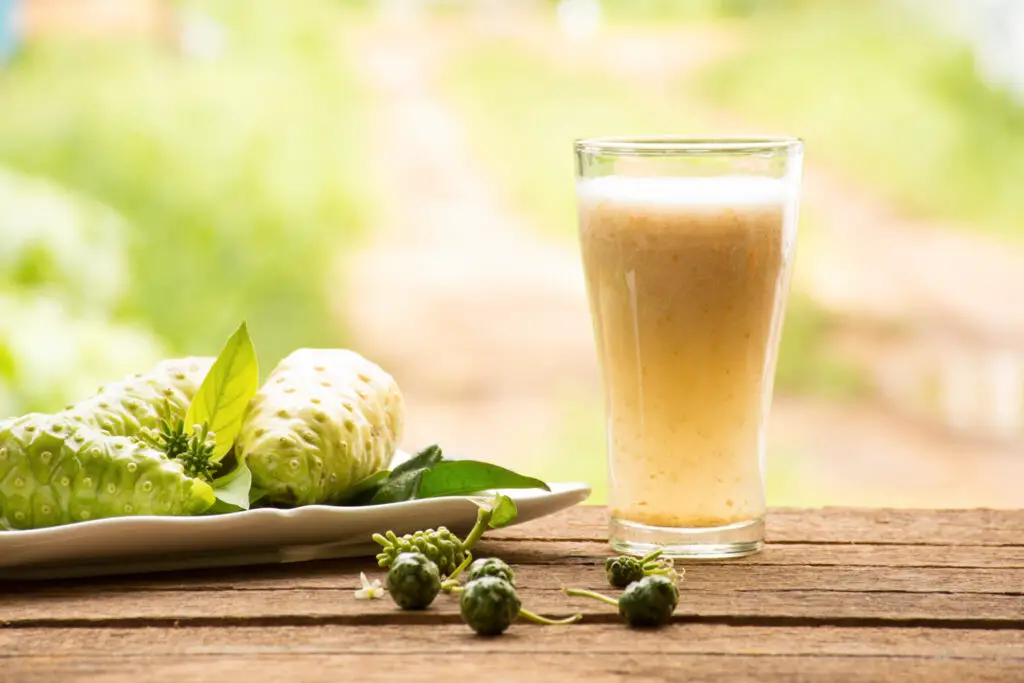
Noni, also known as Indian mulberry, is a tropical fruit native to Asia.
It has been used for centuries in traditional Asian medicine for its numerous health benefits.
The fruit is rich in antioxidants and is low in calories, making it a great addition to any diet.
Noni has a unique taste often described as strong and pungent, with a slightly sour and bitter aftertaste.
The fruit is commonly consumed as a juice or an ingredient in various dishes, adding a distinct flavor to Asian cuisine.
Despite its strong taste, noni has gained popularity for its medicinal properties, which include pain relief, improved digestion, and enhanced immune system function.
Yuzu
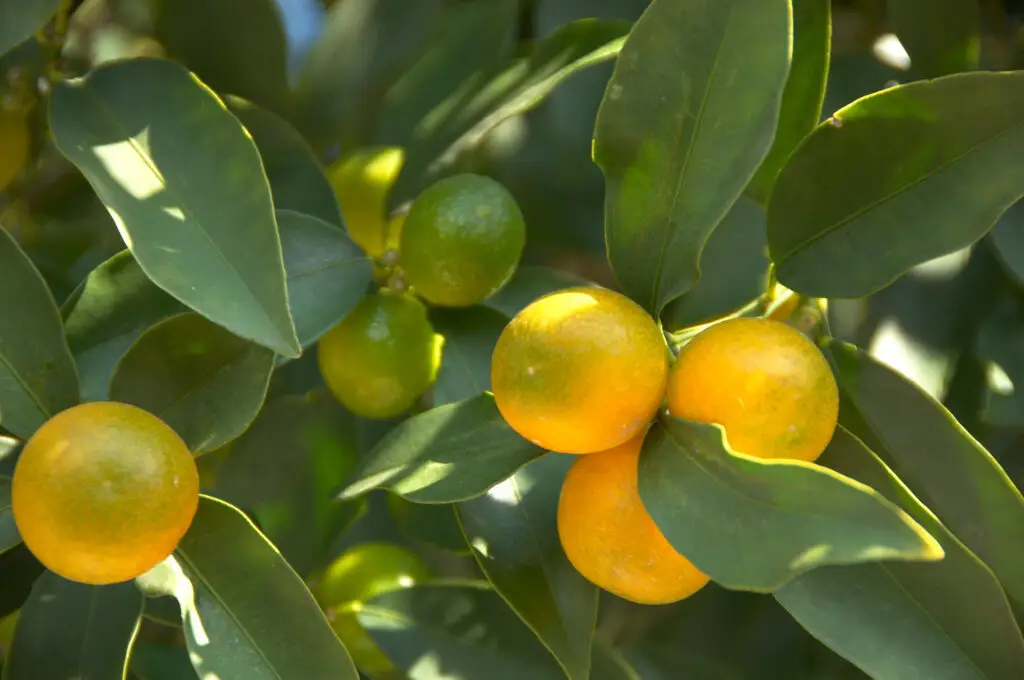
Yuzu is a delightful Asian fruit that has recently gained popularity in Western cuisine.
This citrus fruit is typically grown in Japan, China, and Korea and is believed to be a sour mandarin and ichang papeda hybrid.
The unique flavor profile of yuzu is often described as tart, zesty, and slightly floral with hints of grapefruit and lemon.
Its rind is commonly used in Japanese cuisine for its fragrant aroma and acidic taste, and the juice is frequently used as a seasoning or garnish. Yuzu has become a sought-after ingredient in cocktails, desserts, and savory dishes for its bold and refreshing taste.
Persimmon

Persimmons are a beloved fruit in Asian cuisine, celebrated for their unique flavor and versatility.
These beautiful orange fruits are generally round or oval, with smooth, glossy skins that range from deep red to bright orange.
When ripe, persimmons are soft and juicy, with a sweet, almost honeyed flavor that pairs well with savory and sweet foods.
In Japan, they are often used to make traditional sweets like wagashi, while in China, they are used in stir-fries and soups.
Whether eaten fresh, dried, or cooked, persimmons are a delightful addition to any meal.
Coconut
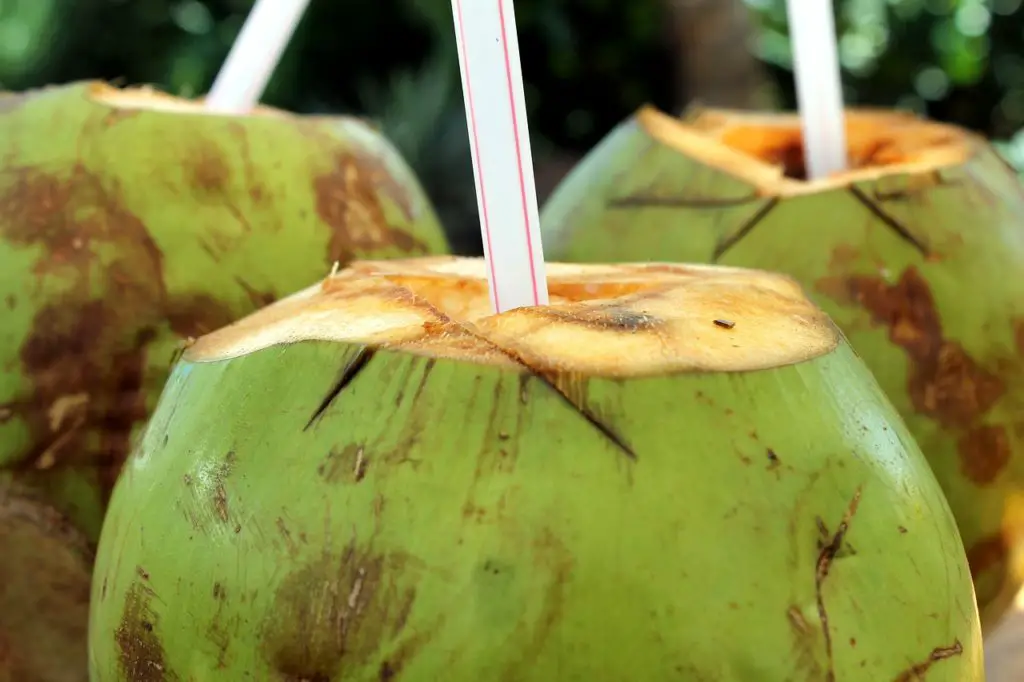
Coconut is one of the most versatile fruits in Asia. From sweet desserts to savory dishes, coconut is a key ingredient in many Asian cuisines.
The fruit’s hard outer shell encases a nut rich in flavorful water and creamy, white flesh.
It’s no wonder why coconut is a popular ingredient in curries, soups, and stews. Not only is it delicious, but coconut also boasts a range of health-related benefits.
It’s packed with nutrients like potassium, magnesium, and iron, making it a great energy source.
Whether you’re indulging in a coconut-based dish or sipping on refreshing coconut water, this fruit is a staple in Asian cuisine that will satisfy both your taste buds and your health needs.
Hog Plum
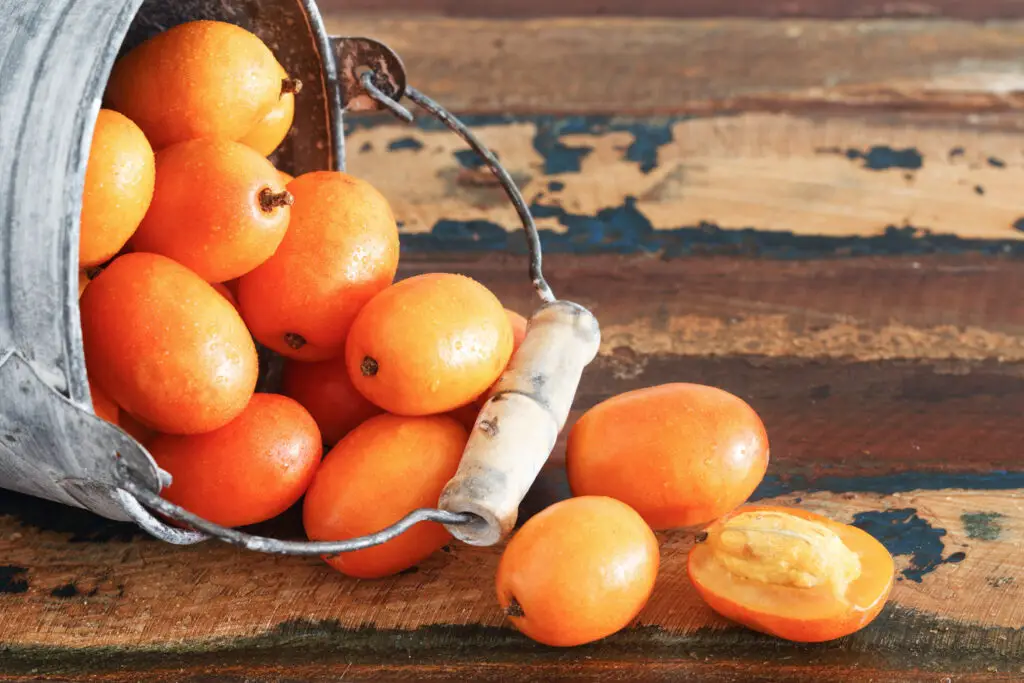
The hog plum is a unique and delicious Asian fruit commonly found throughout the region.
This fruit is small, oval-shaped, and has a thin green skin that encases a juicy, pulp-filled interior.
When ripe, hog plums have a tart flavor with notes of sweetness and are often used in traditional Asian dishes as a souring agent to add depth to the flavor profiles.
They are commonly enjoyed in salads, curries, and sauces and have recently gained popularity as a natural ingredient in weight loss supplements due to their high levels of hydroxycitric acid.
Despite their popularity in Asia, hog plums are still relatively unknown to many outside of the region, making them a rare and valuable find for adventurous fruit lovers.
Gac Fruit
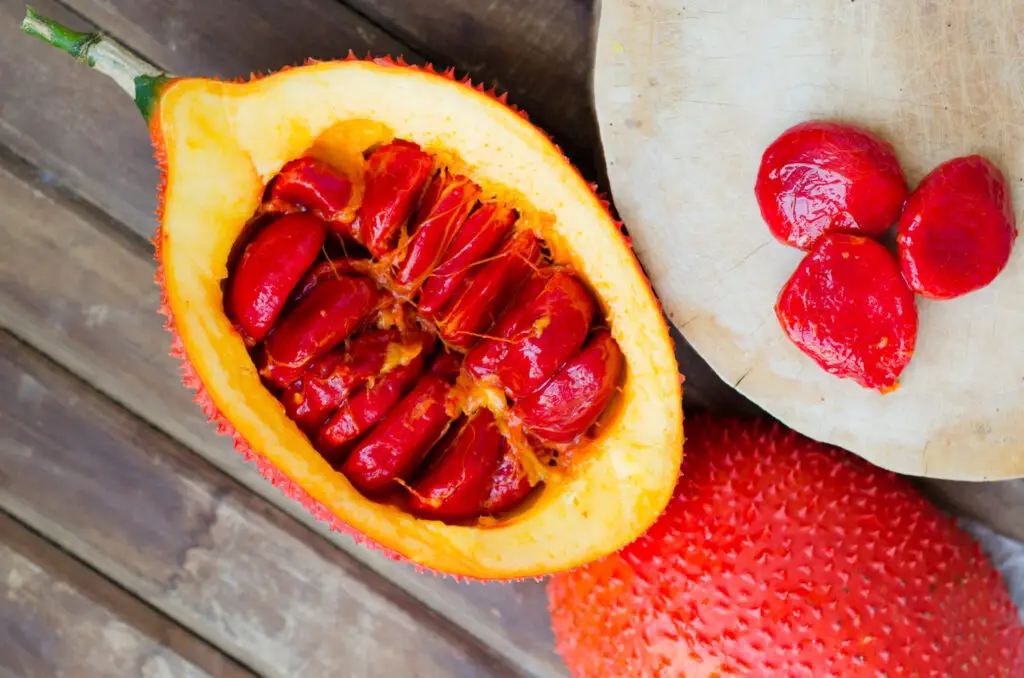
Gac fruit, also known as the “fruit from heaven,” is a typical Asian fruit widely used in traditional medicine for decades.
This spiky, bright red fruit is mainly found in Southeast Asia, where it has been cherished for its potent nutritional and medicinal properties.
Renowned for its high levels of carotenoids, vitamins, and antioxidants, Gac fruit is a popular ingredient in many Asian dishes and beverages.
This exotic fruit is a source of culinary excitement in many parts of Asia, whether it’s added to sweet desserts or savory dishes.
Fuji Apple
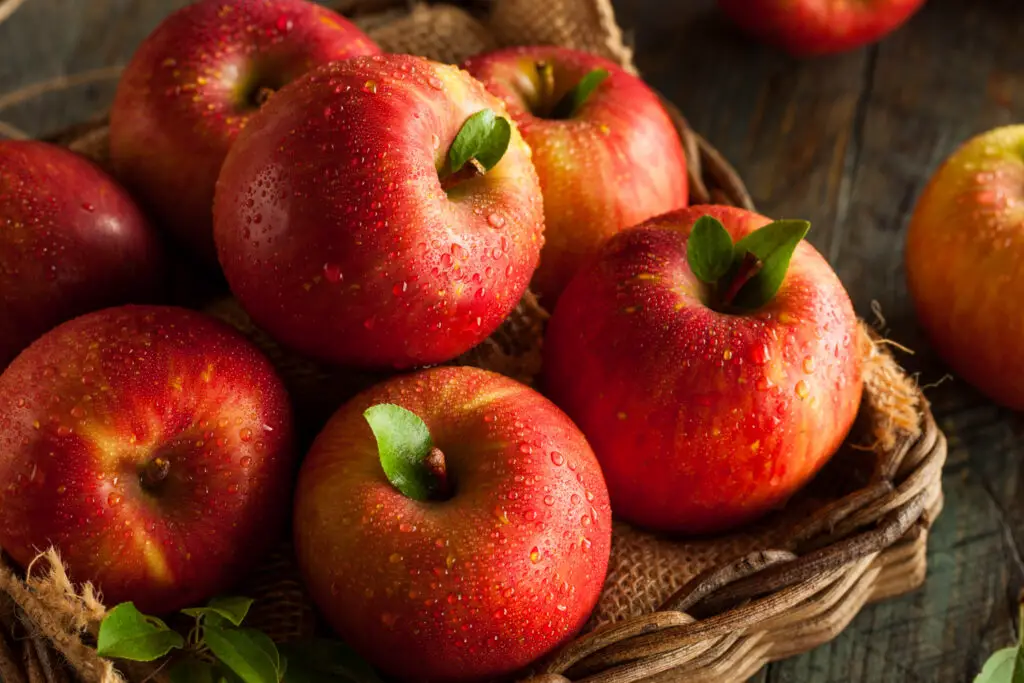
Fuji apple is a delicious Asian fruit that has gained popularity worldwide due to its sweet and juicy taste.
This variety of apples was first developed in Japan by crossbreeding two American apple types, Red Delicious and Virginia Ralls Janet.
The fruit is known for its firm texture and the unique blend of flavors it offers, which includes a perfect balance of sweetness and tartness.
In Asia, this fruit is often used in desserts, pies, and juices, and it has become a symbol of autumn due to its availability during this season.
Conclusion for Asian Fruits
Did you enjoy this look at 39 Exotic Asian Fruits? If so, we have many more fruit-related articles that we didn’t already link to in the post:
- Delicious Pineapple Slushie Recipe
- Fruits That Start With T
- Fruits That Start With W
- African Pear – The Unique African Fruit
So next time you’re in the mood for something new, why not try out some amazing Asian fruits? You won’t be disappointed!
Frequently Asked Questions for Asian Fruits
Mangosteen is known as the Queen of Fruits in Asia. This exotic fruit has a unique flavor and is highly prized in many parts of Asia, particularly Southeast Asia. It is often used for smoothies, desserts, jams, sauces, and more. Its sweet-tart taste and succulent texture make it easy to see why this delectable fruit reigns supreme in the region!
The national fruit of South Korea is the Korean melon, also known as Maesil. This uniquely shaped fruit has a yellowish-green skin and a sweet flavor that is often compared to honeydew or cantaloupe. It is commonly used in jams, beverages, and desserts nationwide. The melon is also high in vitamin C, calcium, and potassium, making it a nutritious addition to any diet.
The national fruit of Thailand is the durian, also known as the “king of fruits”. This spiky-skinned fruit has an intense and pungent odor that some may find too overwhelming. However, its creamy texture and sweet flavor make it a popular treat in many parts of Asia. Rich in vitamin C, iron, and phosphorus, the durian is a nutritious addition to any meal. It can be enjoyed raw or incorporated into curries, soups, salads, and desserts.

